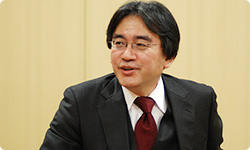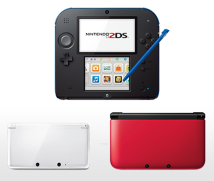2. Luigi’s Mansion 3D That Never Was
Thanks for waiting, Konno-san. Game fans probably know you as producer of the Mario Kart11 series and Nintendogs12, but this time Miyamoto-san gave you the mission of producing the hardware rather than software. 11Mario Kart series: The first instalment in this series of racing games was released in Japan for the Super Famicom (Super NES) system in August 1992. Six instalments have appeared for home consoles and handheld systems. 12Nintendogs: A game released for enjoying communication with puppies. Released for Nintendo DS in Japan in April 2005.
Yes. I have, of course, been involved in development of Mario Kart and Nintendogs + Cats13 for Nintendo 3DS as well, but around the summer of 2008, I came to be overall producer of Nintendo 3DS. 13Mario Kart and Nintendogs + Cats: Software currently under development for Nintendo 3DS. Nintendogs + Cats is scheduled for release in the spring of 2011. The release date of Mario Kart is still undetermined.

A software developer has never been a hardware producer for us before. How did that happen?
I’ll never forget it. Just when I was catching my breath after development of Mario Kart Wii14, opic=3" target=nintendo>I was approached about Nintendo DSi Sound15. 14Mario Kart Wii: A racing game released for the Wii console in April 2008. The sixth game in the Mario Kart series. 15Nintendo DSi Sound: Built-in software for Nintendo DSi and Nintendo DSi XL. It allows users to play music that they have saved on SD Cards and change the playback speed and pitch of the sound.
That came up rather suddenly.
Yes. Miyamoto-san said he wanted sound software no matter what.
He dragged you in just when you were catching your breath.
Yes. (laughs) Then, while I was making that sound software, I heard about the new handheld project. Soon after, Miyamoto-san said he wanted me to produce the overall project. Actually, I’d always liked practical handheld gadgets.
You like digital gadgets more than most people at Nintendo.
Yeah, I love them. But you might like them more than I do! (laughs)
Whenever a new and interesting gadget comes out, we always ask each other, “Did you buy it?” and “Have you tried it out?” (laughs)
Once, way back when you were president of HAL Laboratory, we were talking over something, and you pulled out a PDA and connected it to a cell phone that was really expensive for the time. Making that dial-up modem sound, you began establishing an Internet connection with it.
Yes. (laughs)
When I saw that, I thought, “Wow, that’s amazing!” Because I myself love these new gadgets, I was always jealous whenever I encountered that kind of situation. I was really interested when this project came up, so I accepted the offer and joined Umezu-san and the others.
(laughs) So Konno-san, you became the partner for Umezu-san who was now able to discuss the software and the product’s overall image.
Yes. There were ideas that didn’t include two screens in the beginning, but I thought that a clam-shell design like the Nintendo DS system had would be good. I pretty much suggested whatever I wanted.
Then after development had advanced a bit, the 3D idea came up.
Yes. I think the timing was good. Some of the staff members around me were saying things like, “Today’s 3D LCDs really look good!” I thought so, too. I had a connection with 3D games anyway. After the development of Luigi’s Mansion16 for Nintendo GameCube was over, I was involved in the experiment of making a 3D version of it. 16Luigi’s Mansion: An action-adventure game released simultaneously with the Nintendo GameCube system in September 2001 in Japan.
Luigi’s Mansion 3D. Unfortunately, we never released it.
Yes. We tried fitting the Nintendo GameCube system with a small, roughly four-inch LCD that allowed you to enjoy Luigi’s Mansion in glasses-free 3D.
We showed that LCD as a reference exhibit at the 2002 E317, but kept the 3D aspect secret. I liked that, though. 17E3 (Electronic Entertainment Expo): A video game-related trade show usually held in Los Angeles.
Yes. It had depth, so it really pulled you into the world of the game. I thought it was great, but...
But we just couldn’t get past the problem of how to sell it.
Right. Liquid crystal was still expensive back then, and no matter how new an experience we could provide through the games, there would have been a need for players to buy the LCD as an accessory. There was even talk that it could turn out to be more expensive than the console itself!
In the end, we couldn’t overcome that hurdle and it never made it out into the light as a product. During the days of the NES, though, we did release Famicom Grand Prix II: 3D Hot Rally18 and took on the challenge of 3D games with the Virtual Boy system. Everyone understood the possibilities. But we were painfully aware that unless it was fairly substantial, it wouldn’t really catch on. 18Famicom Grand Prix II: 3D Hot Rally: A racing game released for the Family Computer Disk System in April 1988 in Japan.

Yes, that was very clear.
Sugino-san, you actually worked on Virtual Boy. (laughs)
Because of those hard experiences, when I told people at Nintendo how fun 3D games are, I couldn’t get them to immediately believe in the potential.
Even though Nintendo had continued its efforts in 3D, lots of people in the company were perhaps full of doubt. (laughs)
Yes. I’d propose something, and they’d ask, “Huh? Are we still doing that?” (laughs) I decided to at least experiment. First we made it possible to represent Mario and Luigi in 3D. Then I talked to the development staff of Mario Kart Wii and asked if they could make it in 3D, and it went relatively well. A few weeks later, we could display Mario Kart Wii in 3D on the newest 3D panel. When I saw it, the 3D looked more natural than I had expected. I thought it was good and had some people at the company look at it.
I talked about this Iwata Asks: Nintendo 3DS. Until we experimented, not everyone was ready to give their whole-hearted consent to going with 3D. What did you think about that, Sugino-san?
I, too, had been through some really tough times with 3D. I think I was traumatised by it! (laughs) So the moment I heard the 3D idea, I instinctively reacted against it. I even said, “No, let’s not do that.”
Oh, that’s right! (laughs)
But when I saw the demo, I thought, “Wow! Amazing!” And when other staff members asked me what I thought, I told them that if even someone like me, who had been traumatised, thought it was amazing, then everyone else would definitely think it was amazing, too. It was surprising to see 3D images with my bare eyes.
I think it’s interesting how like Nintendo it is for the software staff to take the lead in creating a prototype and then present it in order to convince the hardware staff, who remembered their travails with the Virtual Boy system. Umezu-san, what was your first impression when you saw it?
Like Sugino-san, I was floored by how good it looked. But I’d had an even bigger shock earlier when I got a call from Konno-san saying he was thinking about putting in a stereoscopic LCD. (laughs)
I bet you thought, “I haven’t heard anything about that!” (laughs)
Yeah. About as shocked as I was when I heard Nintendo DS was going to have two screens.
Right, you first designed the SoC for the Nintendo DS system with only one screen in mind.
Yes. I thought, “Uh-oh...”
